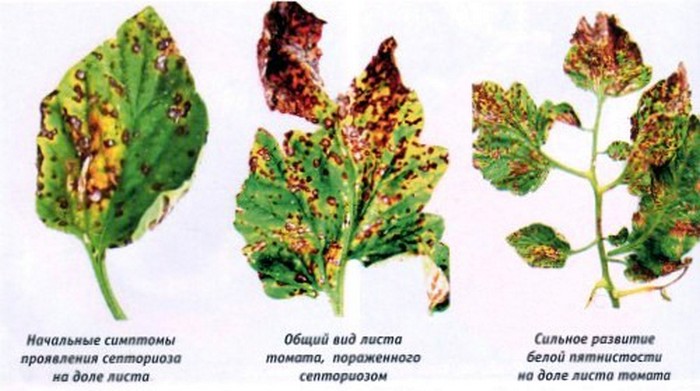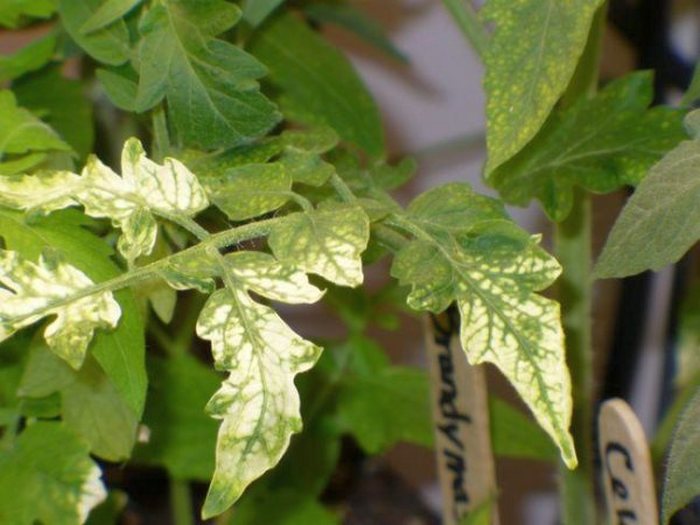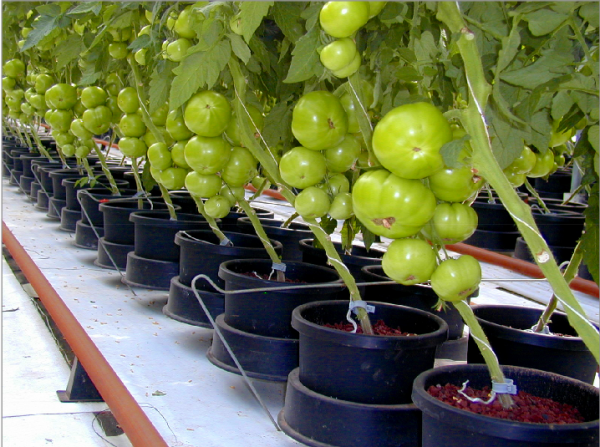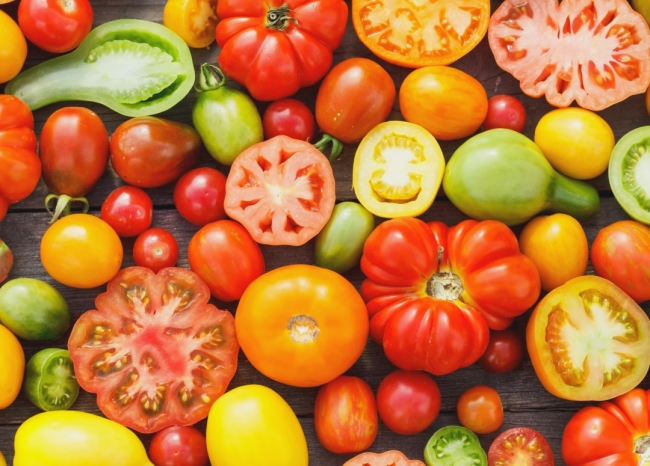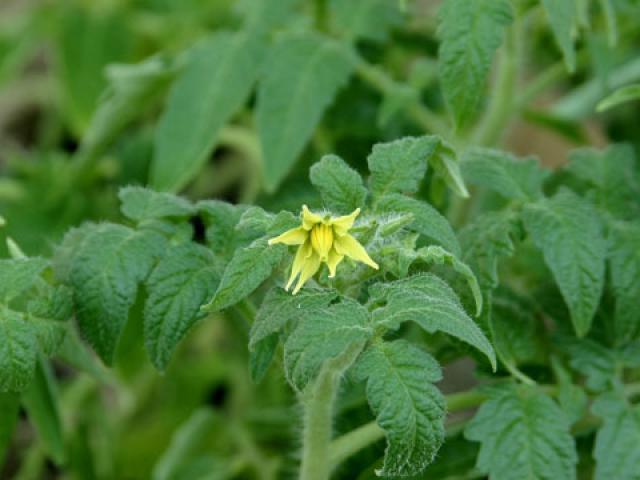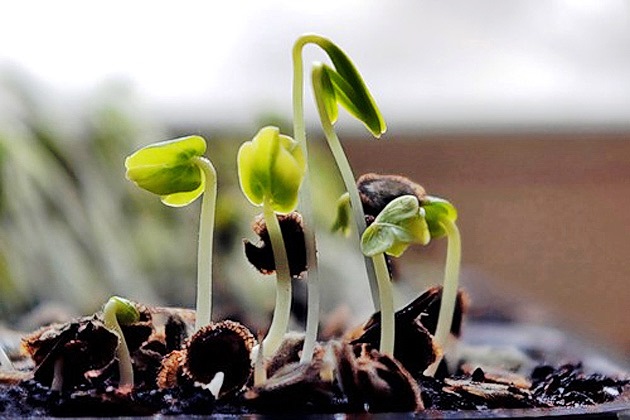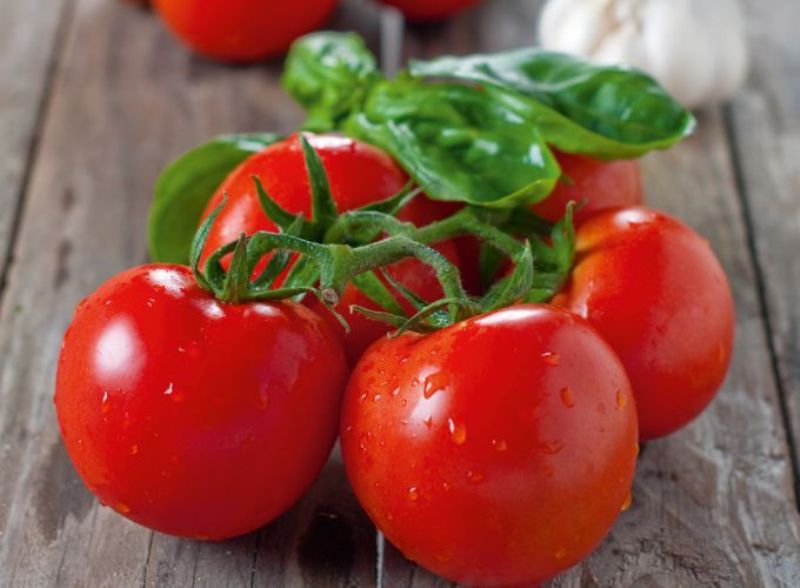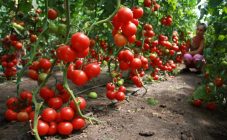Content:
Tomato septoria disease has a second name - white spot. Fungus causative agent - Septoria lycopersici Speg. Despite the fact that the disease mainly affects the leaf plates of the bushes, it sharply reduces the overall yield of the crop - the plants spend too much energy on building up new green mass, stop growing, start bearing fruit late. Why do the leaves turn white on tomatoes, what to do and how to treat plants affected by septoria?
All about tomato disease - septoria
This tomato disease has its own characteristic symptoms, by which it is not at all difficult to determine it.
Septoriosis primarily affects the old lower leaves - it is on them that you can see the initial stage of the development of the disease, then the symptoms appear on the foliage of the higher tiers. First, small red-brown spots appear on the leaf, a little later they turn pale, become covered with a whitish grayish bloom, and black dots form on their surface - pycnidia (fruit bodies) of the fungus. The spots increase in size over time, merge together, and the general picture is as follows: most of the infected leaf becomes dry, while black pycnidial specks can be seen on the dead, pale tissues. The leaf dies and disappears.
On tomato hybrids resistant to this disease, the size of the affected area is small, small spots with a diameter of no more than 2 mm often appear, but there are no pycnidia of the harmful fungus on them. But in varieties prone to infection with septoria, there are more serious problems: brown spots in a short time grow up to 6 mm in diameter, brighten from the center. As a result, these spots look white with a brown border, while they are dotted with black blotches - the bodies of the fungus.
Much less often the disease manifests itself on the stems and petioles. Fruits are extremely rarely affected, specimens with signs of septoria are undesirable to eat. It is possible to collect seeds from such fruits only with their subsequent dressing.
White leaves on tomatoes. The cause of septoria
Most often, septoria occurs on ground tomatoes, their leaves can turn white after planting in the ground. In this case, the affected area can be very large. Less commonly, white spot occurs on protected ground tomatoes (in greenhouses, hotbeds) and is local in nature - it affects individual bushes.
Why do tomato leaves turn white after planting in a permanent place
High air humidity (75-100%) and relatively warm ambient temperature (+ 15… + 20 ° С) are considered favorable conditions for the appearance of white spotting in tomatoes. In closed ground, these conditions arise if the structure is not opened for ventilation after irrigation and during the day, and in open ground - in stable rainy, at the same time warm, weather.
In greenhouses, the appearance of white spot is much easier to prevent than when growing crops in the open air, you just need to follow the rules of agricultural technology. When cultivating tomatoes in open ground, this is not enough, since weather conditions are the main cause of infection.
Having figured out why the leaves of tomatoes turn white, it is recommended to use special fungicidal preparations or use folk remedies to combat septoria.
Methods for treating tomato septoria with special chemistry
To combat this disease, gardeners often resort to the use of chemicals - fungicides.
- Thanos... It works effectively, quickly kills the fungus. A solution of the drug is prepared by diluting 6 g of Thanos in a bucket of water. This amount of working fluid is enough to process 1 hundred parts.
- Revus... For foliar processing of tomato bushes, 10 ml of the product must be diluted in a bucket of water. The consumption of the working fluid is 20-40 ml per bush, depending on its growth rate (determinant / tall).
- Bordeaux... For spraying, prepare a solution of the drug at the rate of 1 g / l of water. This volume is enough to process 20 m2 of plantings. Cannot be used during flowering.
- Fundazol... The drug is characterized by poor water solubility, therefore it is preliminarily diluted in a small amount of water (200 ml), and then brought to the required volume. To prepare the working fluid, dissolve 5 g of Fundazole in 5 liters of water. The protective layer stays on the bushes for 2-3 weeks.
- Ordan... Treatment with this fungicide should be started no later than 2 days after the onset of the disease. The period of protective action is 1-2 weeks. The solution is prepared at the rate of 25 g of the drug per 5 l of water. This amount is enough to process 1 hundredth of plantings.
- Metaxil... It is used to combat septoria in open ground tomatoes. 25 g of the drug is diluted in 3-5 liters of water, and this solution can be used to treat 100 m2... It is recommended to alternate spraying with Metaxil with Ordan.
All of the above special fungicides are very effective, are not washed off by rain, and are very economical.
To prevent the treatment from harming the fruit, you need to follow a few simple tips for spraying tomato bushes.
- Spraying should not be carried out on sunny days, as there is a risk of burning the green mass of tomatoes. The resulting burns will only aggravate the situation, causing even more damage to diseased bushes.
- It is recommended to process ground tomatoes in calm weather.
- For the drug to work effectively, it must be distributed evenly over the entire surface of the plant, while it should not drain.
- Some fungicides, such as Bordeaux, can be harmful to bees and other pollinating insects. Before use, you should carefully read the recommendations on the packaging.
- It is necessary to observe the optimal dosage, otherwise the bushes can get a chemical burn of the leaves.
Folk remedies for the treatment of the disease
If large quantities of white spots characteristic of septoria have appeared on the leaves of tomatoes, alternative methods will no longer help to revive the bushes. Processing with organic infusions in this case will not bring any effect.
If the lesion is focal, for example, in a greenhouse, then the first thing that can be done is to transplant infected specimens in order to isolate them from the general mass. All diseased leaves of these seedlings are cut off and they are treated with preparations containing copper, and they are planted back after successful treatment. If individual bushes were hit too hard, there is no point in saving them, you just need to dig them up and burn them, and treat all the rest with copper-containing agents as a prophylaxis. Among them are the following:
- based on copper sulfate: copper sulfate (1-2 g per 10 l of water), Kupraxat (5 ml of the product per 1 l of water);
- based on copper oxychloride: Abigo-peak (50 g per bucket of water), Hom (40 g per bucket of water).
As folk methods, you can cite the usual preventive measures, thanks to which you can protect the planting from infection with septoria.
- Crop rotation must be observed.
- The structures of greenhouses and greenhouses in which tomatoes are grown must be disinfected in the spring, washed with a solution of copper sulfate (100 g of substance per bucket of water) or use smoke bombs.
- Do not leave plant residues on the planting sites, since the fungus remains in them after infection.
- The planting scheme for bushes should be optimal - they must be planted in compliance with the recommended distances and row spacings. With a thickened planting, ventilation worsens and humidity increases, which contributes to the occurrence of septoria.
- Paying special attention to top dressing can increase the resistance of the bushes to disease, while the lack of any element weakens the plants and increases the risk of infection.
- Before planting seeds, it is advisable to pickle in a fungicide solution.
Chemicals will not be needed if all preventive measures are taken in advance. Why treat tomatoes in a greenhouse if disease prevention is much easier? And for cultivation in the open field, it is enough to choose varieties and hybrids resistant to septoria.
